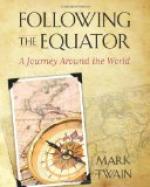Constellations have always been troublesome things to name. If you give one of them a fanciful name, it will always refuse to live up to it; it will always persist in not resembling the thing it has been named for. Ultimately, to satisfy the public, the fanciful name has to be discarded for a common-sense one, a manifestly descriptive one. The Great Bear remained the Great Bear—and unrecognizable as such—for thousands of years; and people complained about it all the time, and quite properly; but as soon as it became the property of the United States, Congress changed it to the Big Dipper, and now every body is satisfied, and there is no more talk about riots. I would not change the Southern Cross to the Southern Coffin, I would change it to the Southern Kite; for up there in the general emptiness is the proper home of a kite, but not for coffins and crosses and dippers. In a little while, now—I cannot tell exactly how long it will be—the globe will belong to the English-speaking race; and of course the skies also. Then the constellations will be re-organized, and polished up, and re-named—the most of them “Victoria,” I reckon, but this one will sail thereafter as the Southern Kite, or go out of business. Several towns and things, here and there, have been named for Her Majesty already.
In these past few days we are plowing through a mighty Milky Way of islands. They are so thick on the map that one would hardly expect to find room between them for a canoe; yet we seldom glimpse one. Once we saw the dim bulk of a couple of them, far away, spectral and dreamy things; members of the Horne-Alofa and Fortuna. On the larger one are two rival native kings—and they have a time together. They are Catholics; so are their people. The missionaries there are French priests.
From the multitudinous islands in these regions the “recruits” for the Queensland plantations were formerly drawn; are still drawn from them, I believe. Vessels fitted up like old-time slavers came here and carried off the natives to serve as laborers in the great Australian province. In the beginning it was plain, simple man-stealing, as per testimony of the missionaries. This has been denied, but not disproven. Afterward it was forbidden by law to “recruit” a native without his consent, and governmental agents were sent in all recruiting vessels to see that the law was obeyed—which they did, according to the recruiting people; and which they sometimes didn’t, according to the missionaries. A man could be lawfully recruited for a three-years term of service; he could volunteer for another term if he so chose; when his time was up he could return to his island. And would also have the means to do it; for the government required the employer to put money in its hands for this purpose before the recruit was delivered to him.
Captain Wawn was a recruiting ship-master during many years. From his pleasant book one gets the idea that the recruiting business was quite popular with the islanders, as a rule. And yet that did not make the business wholly dull and uninteresting; for one finds rather frequent little breaks in the monotony of it—like this, for instance:




